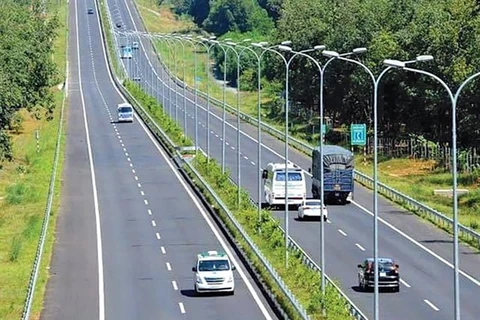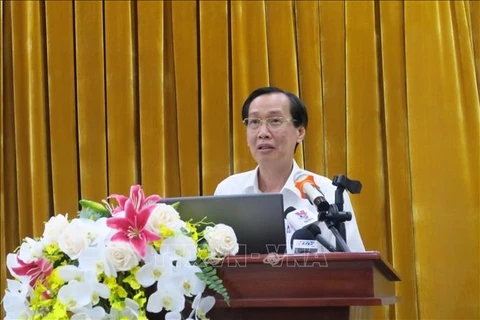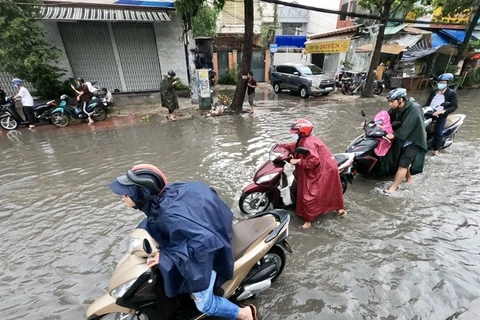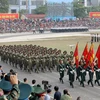 Hours-long congestion on Pham Van Dong Road leading to Tan Son Nhat International Airport. (Photo: VNA)
Hours-long congestion on Pham Van Dong Road leading to Tan Son Nhat International Airport. (Photo: VNA)HCM City (VNA) – Ho Chi Minh City allocates about 10 trillion VND (431.9 million USD) a year for the transport sector but the funding does not seem to be enough for narrowing the gap between the local infrastructure system and travel demand, heard at a meeting on June 10.
The event was held between a delegation of supervisors from the municipal People’s Council and relevant departments and agencies on the progress and efficiency of key transport projects in the city.
Work has completed on 39 out of the 172 projects under the programme on reducing traffic congestions and accidents while 78 others are still in progress, said Director of the municipal Department of Transport Tran Quang Lam.
Most of the transport projects in the city are far lagging behind schedule, for example the 64-km belt road No.2 crossing eight districts. Though the project is slated to complete this year but to date, construction has done on about 50km of the road while the remaining sections are in progress.
Lam said from 2016 – 2020, the traffic congestion and accident reduction programme has received more than 12.62 trillion VND from the State budget, only equal to around 27 percent of the target.
The city hopes to get the remaining funding from the private sector through the Public-Private Partnership scheme but only 13 percent of the financial needs have been met, or close to 16.97 trillion VND, over the last five years.
The Department of Transport has proposed the municipal People’s Council to prioritise capital from the medium-term public investment plan for the 2021 – 2025 period for projects under the city’s transport infrastructure development plan by 2030.
At the same time, the HCM City People’s Committee has asked relevant departments and agencies to revise and issue special mechanisms and policies for luring investment into the city’s transport infrastructure projects in line with the National Assembly’s Resolution No.54 on related matters.
In her remarks at the meeting, Chairwoman of the municipal People’s Council Nguyen Thi Le said the large number of long-delayed projects has severely affected daily lives of local residents, adding the projects have failed to reach expectation when it comes to efficiency.
One of the reasons behind this is the lack of an effective cooperation between relevant departments, agencies and districts in various stages of the projects, particularly site clearance, she noted.
The city leader requested the Department of Transport to come up with effective solutions to accelerate the disbursement and the progress of key projects.
It was also asked to not stretch investment across too many projects but focus on important ones to soon put them into use.
Le ordered the Department of Environment and Natural Resources to adopt new policies on compensation rates and residential relocation supports, suitable to the city’s current socio-economic situation.
The Department of Investment and Planning was tasked to earmark sufficient funding for the projects under the traffic congestion and accident reduction programme to prevent them from being further delayed.
Ho Chi Minh City is the largest city in Vietnam and the economic hub of the southern region. Accounting for 0.6 percent of Vietnam’s total land area and about 9 percent of the country’s population, it is part of the southern key economic zone, which also comprises Dong Nai, Ba Ria - Vung Tau, Binh Duong, Long An, Tay Ninh and Binh Phuoc provinces. In the southern economic hub, over 3,000 projects across all sectors are supported by foreign capital, while the number of registered enterprises has exceeded 100,000.
In 2019, the city attracted 8.3 billion USD worth of foreign investment, with its labour productivity being nearly three times that of the whole country (299.8 million VND per person, an increase of 6.8 percent over 2018).
The local gross regional domestic product (GRDP) reached more than 1.34 quadrillion VND, an 8.32 percent increase year-on-year.
Before the outbreak of COVID-19, the city set a target of achieving a growth rate of 8.5 percent for GRDP in 2020, with total private investment accounting for 35 percent of GRDP./.
VNA























